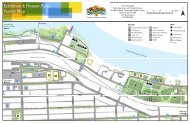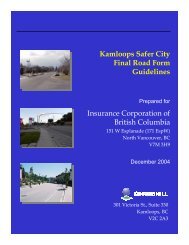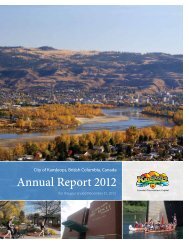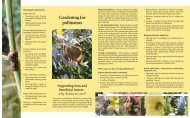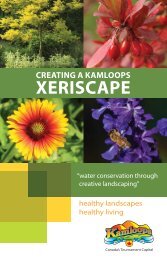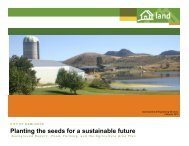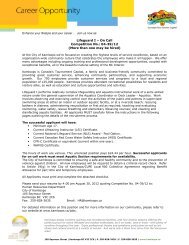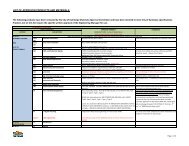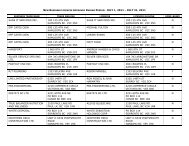GEOTOUR GUIDE - City of Kamloops
GEOTOUR GUIDE - City of Kamloops
GEOTOUR GUIDE - City of Kamloops
You also want an ePaper? Increase the reach of your titles
YUMPU automatically turns print PDFs into web optimized ePapers that Google loves.
The mininG proCess<br />
Rock is blasted from the mine pits and hauled by truck to a rock crusher in the bottom <strong>of</strong> the pit. There the rock fragments are<br />
broken to the size <strong>of</strong> a football and carried by a conveyor belt to the mill. In the mill the rock is ground to mud, freeing the<br />
individual grains <strong>of</strong> copper and molybdenum from rock. This rock mud is mixed with a soapy detergent that clings to metals.<br />
Metal-rich “suds”, one copper-rich and the other molybdenum-rich, are separated, dried, and trucked to Ashcr<strong>of</strong>t and loaded on<br />
trains. The dried metal concentrate is sent to smelters in eastern Canada, Asia, and Europe where it is turned into pure copper<br />
and molybdenum metal. A slurry <strong>of</strong> waste rock mud from the mill is pumped by pipeline to a storage reservoir (tailings pond).<br />
Figure 42a. Large cylindrical mills grind the ore from football<br />
size blocks to silt.<br />
environmenTal manaGemenT and reClamaTion<br />
Highland Valley Copper is implementing a reclamation plan so that when mining is over, the site is left in a safe and productive<br />
state, as similar in appearance to the surrounding landscape as possible to support local wildlife and ranching. To date 25% <strong>of</strong> the<br />
disturbed land has been replanted. Old rock dumps and tailings ponds have been covered with a soil layer and replanted with<br />
grasses and seedlings. A replanted tailings pond is currently being tested for cattle grazing. Trout have been stocked in another<br />
former tailings pond, which even supports a fishing derby!<br />
Figure 42b. Flotation tanks in the mill separate a detergent “suds” rich in metal<br />
particles from other fine rock particles. Sand and mud are pumped as a slurry by<br />
pipe to a storage reservoir. (Photo by R.Turner)<br />
Figure 43. The tailings pond for the Highland Valley mine contains<br />
white rock mud, the waste product <strong>of</strong> the milling process. The water in<br />
the pond has an aqua blue colour due to reflection <strong>of</strong> sunlight from the<br />
white lake floor (swimming pools are painted white to create this same<br />
beautiful blue colour). When mining has ended, the tailings pond will<br />
be drained <strong>of</strong> water, and its surface covered with soil and planted with<br />
grasses to transform it into pasture or meadows for cattle or deer.<br />
(Photo by R.Turner)<br />
Figure 44. A view <strong>of</strong> the active mining area and surrounding reclaimed mine dumps. The reclaimed mine dumps are golden brown grasslands that<br />
have been smoothed, covered with soil, and planted with grasses. The conveyor belt is the white diagonal line and transports ore from the mine pit<br />
(lower right) to the mill (centre and hidden behind active rock waste dumps). (Photo by R. Anderson)<br />
25




